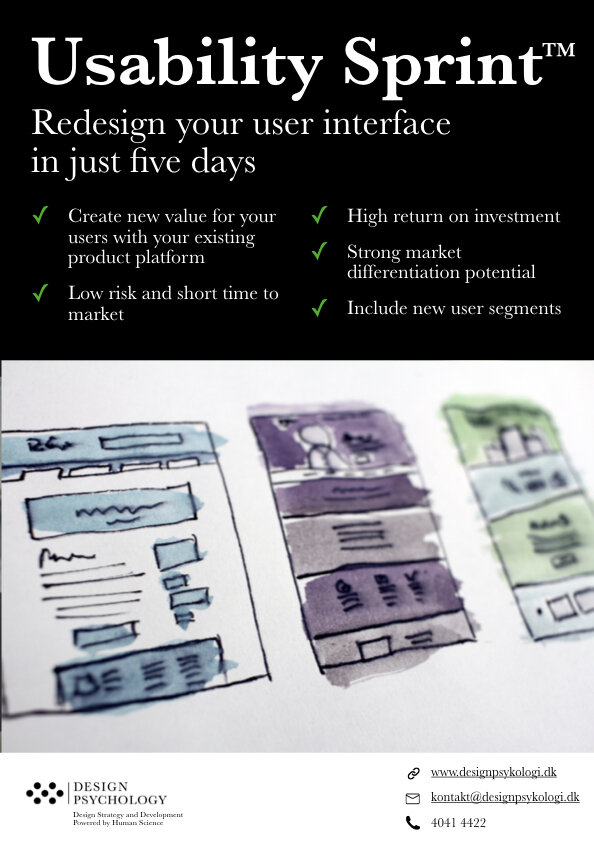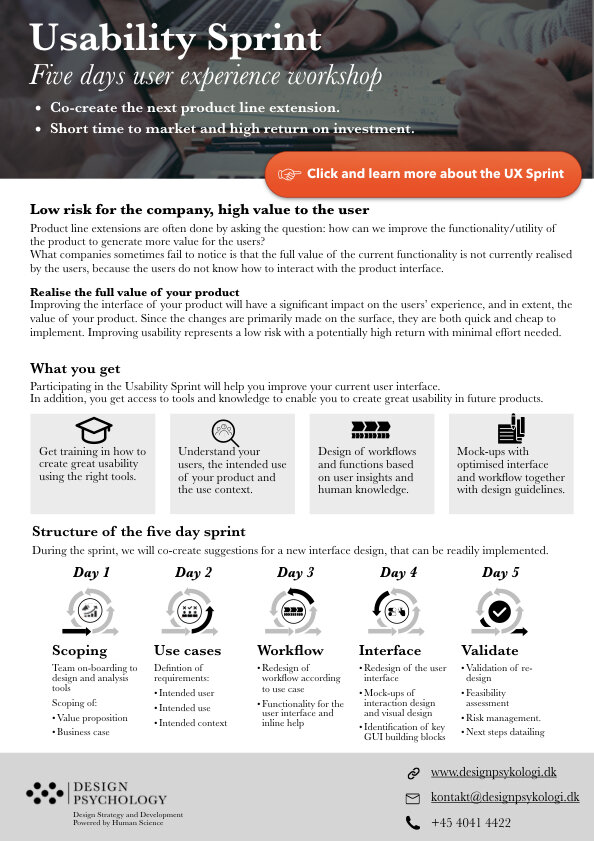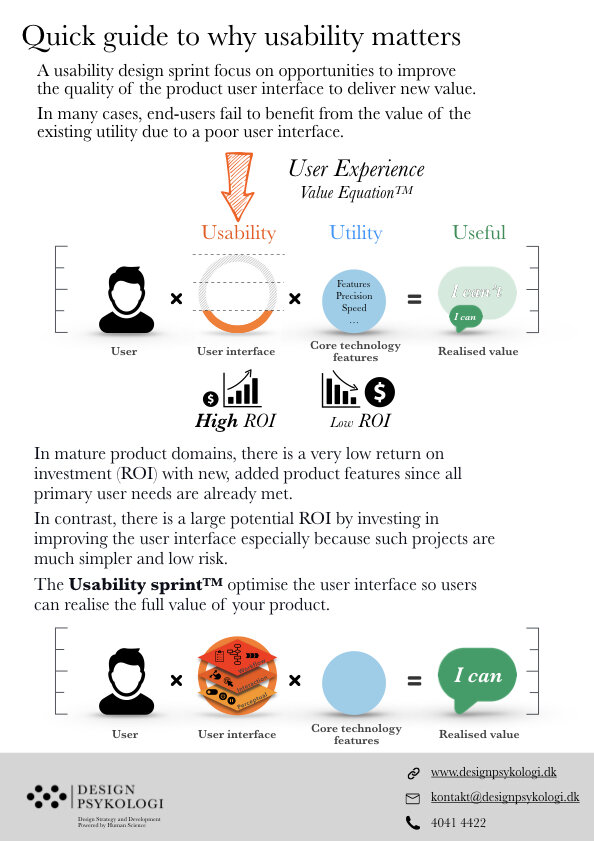Usability Design Sprint
Create added value for the users in just five days.
Key takeaways:
– Usability Design Sprints maximise the existing value in your product portfolio
— A feature-driven design strategy erodes Return on Investment once primary user needs are met
You have likely heard of the “Design Sprint” methodology. At Design Psychology, we use this method ourselves and regularly participate in these one-week Design Sprints that allow companies to go from a problem to validated concepts in just five days. However, there is another kind of Design Sprint that can fast-track line-extensions of your existing products and services in a low risk - but a high gain way. This is called the Usability Design Sprint. In this article, we will talk about the value of the Usability Design Sprint in relation to the classical design sprint. Also, we will detail what a five day Usability Design Sprint looks like at Design Psychology - and how you can get started with it.
Design Sprints and Usability Design Sprints
With Design Sprint, we refer to the particular design thinking method applied in a five-day process, developed by Jake Knapp in the Google Design Sprint Method.
If you are not familiar with this video is a great resource.
Design Sprints are all about finding design solutions that solves challenges that real people have in their daily lives. Now consider this question - what if there is already a great tool for the job but it isn't easy to use. So there is already a potentially really good solution - but it is limited to few people or to very narrow use cases. In such a case, the regular Design Sprint would be of little value. Instead, we should engage in a sprint that focuses not on new product solutions, features and functions, but on how to get more out of what is already a great tool from a functionality perspective.
For many companies this represents a major business opportunity. Rather than developing complex new features or optimise on existing ones, they could instead focus on how to support users in realising the full value of the existing technological potential that is already there.
The traditional design sprint and the usability sprint focus on two different parts of the product value drivers.
In sum the classical Design Sprint focuses on new solutions related to the utility of a product or service. In contrast the the Usability Design Sprint focuses on the Usability of a product or service. Both are essential to deliver value. However, if you already have great Utility - you may consider how improved usability could be a strong value driver for your customers and business.
This relationship is encapsulated in the simple value equation: Usability x Utility = useful. We have previously gone into depth about the business-case for focusing on Usability in a three-part articles series Strategic UX Design. We therefore encourage you to take a look at those articles as well.
Low risk for your company, high value for your users
The regular Design Sprint is focused on exploring entirely new design solutions from scratch. To launch entirely new products is a time-consuming and risky affair, especially in high-tech products like those found in business-to-business and healthcare technology.
That is why line extensions of existing products, where an already proven platform is re-used by adding new features, is a very desirable and frequently used strategy. However, as products mature from extension to extension, the potential to deliver new value becomes smaller and smaller. As a result, we often experience that the added features become “exotic” with marginal use-cases. In short, the value-potential of the Utility-driven design space has been fully explored and is exhausted.
However, for most product categories the inherent value potential of the existing products and features are seldom fully realised by the users due to limitations in Usability. Typically, we see that the user interface Usability suffers from:
Too high complexity.
A poor workflow.
Lack of relevant feedback or maybe even wrong feedback.
Hard to discriminate visual elements.
Inconsistencies in layout, visual elements and wording.
All of these are usually cheap and simple to re-design as they do not require changes to the core-technology or back-end system. Therefore, instead of adding new features, the value potential of the existing features and functions can be made more readily available by focusing on improving Usability.
The business case for improving Usability can for instance be to make existing functionality:
Available to a broader user base / more types of users (such as less experienced and skilled users).
Available to more use cases and scenarios (such as more demanding situations where current solutions fail).
Available to existing users in a shorter amount of time (i.e. shorter on-boarding time).
More robust to use (resulting in fewer errors, shorter time on task, better task completion).
These are just a few of the typical business cases metrics that we we explore on day one of our Usability Design Sprint.
For many companies with an existing product portfolio on the market we, therefore, suggest to re-orient their development towards Usability. However, the existing Design Sprint is not a good tool for this job. Instead, we need a tool that is optimised for exploring the Usability design both from a strategic business-angle and a design development angle. That is exactly what the Usability Design Sprint does.
Get started with the five-day usability sprint.
To get your started with doing a Usability Design Sprint, below you can find the five day program we use at Design Psychology. If you want help with getting started, you can book us for a free presentation where we will walk you through the process and together explore what the business case might look like for your company.






